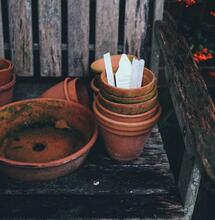How to Grow Stronger Weed

Possibly every grower hopes for the best harvest. Some focus on yield, others look for optimal taste and some aim for the best of both. Taste and potency is what usually matters the most when people speak about quality. Today we will look into the possibilities of maximizing the quality of both.
Cannabinoids
Before we dive into the techniques of increasing the potency of your weed, let us refresh our knowledge on where and how the active substances in cannabis are produced. This plant contains 1269 known substances in total, of which 144 are cannabinoids, 150 terpenes and terpenoids, and 50 flavonoids. The most psychoactive cannabinoid is, of course, tetrahydrocannabinol – THC. Cannabidiol (CBD) is another important member of this group. These two cannabinoids are the most abundant in cannabis. They are at the center of attention of recreational cannabis users because they both contribute to the psychoactive experience. Both of them also exert significant medical effects, which is the reason why cannabis has been used in medicine for thousands of years now. Another interesting cannabinoid from medical point of view is cannabichromen (CBG). The effects of individual cannabinoids are still being explored – and thanks to the fact that cannabis is now becoming accepted by modern medicine (in addition to a global wave of legalization) – we can only expect more and more interesting discoveries. [caption id="attachment_8222" align="alignnone" width="500"] Glandular trichomes with resin, the trichome to the left is non-glandular. Source: www.uk420.com[/caption]
Terpenes
Cannabinoids have many interesting effects, but they lack any sort of taste. If you have ever lived under the impression that the characteristic cannabis smell is caused by a cannabinoid, you were sadly mistaken, as were many others. The taste and smell of cannabis is the result of a unique mixture of terpenes, of which many can be also found in totally different plants. Terpenes themselves possess a wide variety of therapeutic properties, both physical and mental. The most abundant terpenes in cannabis are myrcene, pinene, limonene, linalool, caryophyllene and eucalyptol. Myrcene can be found in mangos and hop, pinene in pines, limonene in citrus fruits, linalool in lavender, caryophyllene in pepper and clove, and eucalyptol in eucalyptus. Sounds familiar? No wonder, these names are often used to describe the taste and smell of specific strains. Mango and other citruses also appear in the actual names of strands – Mango, Lemon Haze, etc. Individual strains’ differentiation can be based on the presence and proportions of terpenes called the terpene profile. It also seems that terpenes modify the effect of cannabinoids. And what is for sure, terpenes influence the overall medical effects of cannabis, something we call “synergy” of all the substances contained within the plant. This means that if we give someone isolated THC, the effect will be rather different from the application of the whole variety of active substances present in whole cannabis plant, namely in its resin. Cannabinoids, terpenes and other compounds work together and influence the overall effect of the plant on its consumer.
Resin
Cannabinoids and terpenes are secondary metabolites found in cannabis resin, which forms in trichomes. Trichomes can be found in a huge number of plants. They have several functions: the most important one is to protect the plants from outside danger, i.e. pests and unwanted animal guests. Plants can also communicate with the outside world through trichomes, all thanks to above mentioned secondary metabolites. When a plant wants to lure a pollinator, it produces smell, which attracts a specific species of insect. When it wants to repel parasites, it produces an unpleasant odor, which parasites do not like. Plants have created their own specific cocktails of secondary metabolites with various effects. Cannabis has two types of trichomes – non-glandular and glandular. Non-glandular trichomes look similar to glandular trichomes but they do not produce resin. Since we are interested in taste and potency, glandular trichomes are of interest to us because they create resin rich in cannabinoids and terpenes. The largest amounts of resin are produced on trichomes on female flowers. You might ask why cannabis produces resin containing cannabinoids. As mentioned, trichomes serve primarily as a defense mechanism. Cannabis resin is sticky and can easily capture harmful insects. The consensus is that cannabis produces cannabinoids to defend itself from mammals who have aggressive digestive tracts and well-developed endocannabinoid systems. When a mammal eats a cannabis plant, its seeds lose value and reproduction is rendered impossible. This means that being consumed by a mammal is undesirable for cannabis. On the other hand, being eaten by birds has positive results. Birds can move seeds to new places where they grow into new plants. So, cannabis resin is meant to turn away mammals – obviously cannabis could not know that it will be smoked and eaten by humans – and the high cannabinoid content is probably supposed to cause unpleasant effects as well as prevent future consuming. Another theory states that the negative effect of cannabis on short-term memory is purely a tactical move – the plant wants to make sure that whoever finds it will not be able to find again where they are growing. It does seem logical. [caption id="attachment_8223" align="alignnone" width="500"] Petals covered with glandular trichomes.[/caption] Nonetheless, we should be interested in a completely different issue: The production of resin as a means of defense. There exists a proven link between resin production and the level of stress the plant feels – it produces the biggest amount of resin when it feels threatened. Bingo!
Plant in Danger
Now that we know that a stressed plant produces more resin, we must think about how to make it stressed. Those with some experience in growing may have noticed that even if the yield is not ideal, the material can still taste great and have great effects. This can pose a bit of a problem if we are focused on both quality and quantity. A plant under stress produces more resin but does not reach the maximum yield. This means that if we expose plants to stress, we should be expecting a lower yield. The exact degree depends on which stress method we use.
Irrigation
Probably the easiest way to stimulate resin production is to modify the irrigation cycle. Inadequate watering works best. When the plant does not get enough water, it begins to wither, it becomes stressed and triggers higher production of resin. Inadequate watering can be done both indoors and outdoors, although outdoor growing relies on the weather. When growing inside a greenhouse, there are as many possibilities as when growing with the use of artificial lights inside. Plants can be put under stress during the entire growing cycle by watering them only when they begin to wither. We must not overdo it, though. In the initial stages, the leaves begin to drop and they become softer to touch, yet the top of the plant still stands upright. In the second phase, the leaves begin to fade towards the ground and the tops of branches begin to droop. In the third phase, the leaves are visibly wrinkled, the leafstalks grow smaller and the plant begins to lose color. When putting the plant under stress during the growth cycle, it should reach max phase two before watering, although watering it right before this phase begins is ideal. If left without water until phase three, the plant might never fully recover. The leaves fall off and parts of the flower could dry out. This method of resin production stimulation is long-term and the resulting harvest is significantly smaller, although very potent. The method carries the risk of the plant dying, that is if we overdo it. The next method of irrigation-induced stress is much safer, and it is also my favorite one. It involves growing and watering the plants all throughout the growth cycle until the last week or two. In the second-to-last week before harvest, the plants are left to wither until phase two. They are then watered, so that they can recover. During the last five days before harvest, they are not watered at all. On harvest day, they should be at phase two again. It is easy to use this method when growing indoors and in a greenhouse. When growing outdoors, the plants must be protected from rain and humidity, which may be difficult especially during autumn. The method has another positive effect – it decreases the risk of mold. When the plant does not get enough water, there is a decrease of humidity inside its flowers, which is where mold frequently appears. Mold needs humidity and warmth, thus eliminating humidity makes mold’s life considerably harder. Putting the plant under stress during the last two weeks of its life has only minor negative effect on yield when compared to long-term stress.
Temperature
Another way to put your plants under stress is to maintain very high temperatures. This goes hand in hand with the previous method – to a certain degree. High temperatures cause water to vaporize quickly, which leads to quicker withering. This in turn leads to a higher production of resin. The temperatures, however, should not exceed 40 °C (104 °F). Since regulating temperature is harder than modifying the irrigation cycle, this method is quite complicated. For this reason, I do not really recommend it, although it is still necessary to mention it. [caption id="attachment_8224" align="alignnone" width="500"] UVB light for reptiles is also suitable for our purposes.[/caption]
UV-B Light
The last method of increasing resin production I would like to mention is UVB light. This ultraviolet light of the 280-315 nanometer wavelengths reaches the ground in very small amounts, and, frankly, we should be glad that it does. UVB light causes skin cancer and damage to eyesight. Plants do not like it too much either, because it decreases the effectivity of photosynthesis and even affects the size of leaves. UVB light simply puts plants under stress, which is what we want right now. UVB light grows in intensity in the middle of spring, which is why plants harvested in July and the beginning of August have more active substances than plants harvested during the fall. When growing indoors, we can use artificial UVB light. Light sources with higher production of UVB light are sold in specialized growing shops or aquatic stores. These light sources must be added to already existing sources. When using 100W classic growing lights, we add 10W source of UVB light. This means that a 60W UVB light source must be added to 600W HID lamps. It is important to think of your health, though. When entering the room with a UVB light source, you must first turn it off or put on skin protection. When using UVB light, five or six weeks of stress before the harvest are enough. The light also eradicates mold to a certain degree, which is a positive side effect. The UVB method is a bit costly, but it is reliable and it does not affect the yield too much. Mr. Jose



.png)